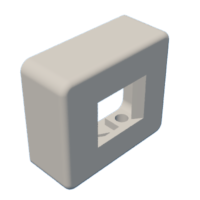Introduction: LED Hour Timer
An hour-timer. When it's not in the timer mode the colors change extremely slowly. Once you press the tiny toggle switch the timer will start. It'll do a little dance before starting 60 minutes timer. During the 60 minutes, the color will change from green to red. Once the time is up it will keep on doing a fast passed looping dance until you press the toggle switch. If you need to interrupt the timer just press the toggle switch and it will interrupt the timer but not without doing the sacred LED looping dance.
Attachments
Supplies
ATTiny85 :- https://www.aliexpress.com/item/606895785.html
Toggle switch
LED strip :- https://www.adafruit.com/product/4310
Step 1: Wiring Instructions
The AtTiny85 shown in the wiring diagram is a different model than the one casing is designed for. However, the wiring will remain exactly the same.
Connect the LED Data pin to P1 of AtTiny 85. You can solder the wires to the LED strip but don't yet solder them to the AtTiny85.
Step 2: Power for the LED
Connect the LED +5V to 5V on AtTiny 85. As I only have 19 LEDs in this project I am powering them from AtTiny85 but if you intend to use many more, use an external power supply for the LEDs.
Step 3: LED Ground
Connect the LED ground to GND on AtTiny 85.
Step 4: Toggle Switch Input
Connect one leg of your toggle switch to the P3 of AtTiny 85. The switch can already be soldered.
Step 5: Toggle Switch Ground
Connect the diagonally opposite leg of your toggle switch to GND on AtTiny 85.
Step 6: Uploading Code
Upload the attached code to your AtTiny85 or any other Arduino microcontroller.
Step 7: Printing the Frame and Box
Print the attached STL files. You don't need support with any of these parts.
Step 8: Putting It All Together
Install the LED strip to the 3D-printed heart-shaped frame. If your number of LEDs is different than mine then change the NUM_LEDS variable to the however many LEDs you have on your strip.
Once the LED strip is installed insert the wires from the top hole of the AtTiny85 box. Once the wire is inside you can solder the wires to the AtTiny.
Step 9: Securing the AtTiny85 and the Switch
There are holes in the AtTiny box model for the toggle switch and AtTiny's micro USB port. As I am not planning on opening mine I used some sponge and hot glue to put the AtTiny and toggle switch inside the box. Make sure there is no short-circuiting when you put it all together in the box. I used some sponge to make sure that both the toggle switch and AtTiny85 remain in their respective positions. As hot glue comes off easily, it won't be much hard for me to disassemble the whole thing.
The lid is designed to stay in with friction. So, just push it in and it should stay in place.
Step 10: Thank You and Have Fun Making
The same code should work with other microcontrollers as well. I have tried using it with Arduino Nano and it worked just fine.
If you would like to have a look at my other silly little projects you can have a look at them here: https://www.instagram.com/yui_maker/













![Tim's Mechanical Spider Leg [LU9685-20CU]](https://content.instructables.com/FFB/5R4I/LVKZ6G6R/FFB5R4ILVKZ6G6R.png?auto=webp&crop=1.2%3A1&frame=1&width=306)


